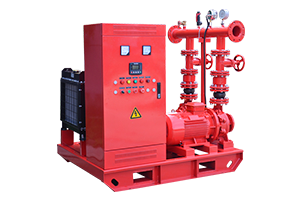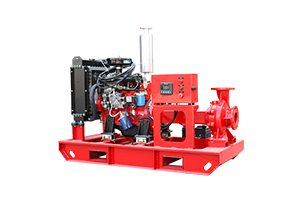What are the considerations for selecting the appropriate motor for an electric fire pump?
Apr 01, 2024
Share:
Selecting the appropriate motor for an electric fire pump involves several considerations to ensure optimal performance and safety. Here are some key factors to consider:
1. **Power Requirements**: Determine the power requirements of the fire pump based on the flow rate and pressure needed to meet the fire protection system's demands. This will help determine the motor's horsepower (HP) rating.
2. **Voltage and Frequency**: Ensure that the motor's voltage and frequency match the electrical supply available at the installation site. It's crucial to adhere to local electrical codes and standards.
3. **Enclosure Type**: Choose a motor enclosure type suitable for the environment where the fire pump will be installed. For indoor applications, an open drip-proof (ODP) or totally enclosed fan-cooled (TEFC) motor may be appropriate, while outdoor installations may require weatherproof or explosion-proof enclosures.
4. **Efficiency**: Select a motor with high efficiency to minimize energy consumption and operating costs over the pump's lifecycle. Look for motors that comply with relevant efficiency standards, such as NEMA Premium Efficiency or IE3 (International Efficiency).
5. **Temperature Rating**: Consider the ambient temperature conditions where the fire pump will operate. Choose a motor with a temperature rating that can withstand the expected operating temperatures without overheating.
6. **Starting Method**: Determine the appropriate starting method for the motor based on the pump's requirements and the available electrical infrastructure. Common starting methods include direct-on-line (DOL), star-delta, soft starters, and variable frequency drives (VFDs).
7. **Reliability and Durability**: Opt for a motor from a reputable manufacturer known for producing reliable and durable products. The motor should be designed to withstand the rigors of continuous operation and be resistant to moisture, dust, and other environmental factors.
8. **Certifications and Compliance**: Ensure that the motor complies with relevant safety and performance standards, such as UL (Underwriters Laboratories), CSA (Canadian Standards Association), or other local regulatory requirements. Additionally, consider certifications specific to fire protection applications, such as FM (Factory Mutual) approval.
9. **Service and Support**: Choose a motor from a manufacturer or supplier that offers reliable technical support, spare parts availability, and maintenance services. This ensures prompt assistance in case of any issues with the motor during installation or operation.
10. **Cost Considerations**: Evaluate the initial cost, as well as the long-term operating and maintenance costs, when selecting the motor. While it's important to stay within budget constraints, prioritizing quality and reliability can ultimately result in lower total cost of ownership over the motor's lifespan.

1. **Power Requirements**: Determine the power requirements of the fire pump based on the flow rate and pressure needed to meet the fire protection system's demands. This will help determine the motor's horsepower (HP) rating.
2. **Voltage and Frequency**: Ensure that the motor's voltage and frequency match the electrical supply available at the installation site. It's crucial to adhere to local electrical codes and standards.
3. **Enclosure Type**: Choose a motor enclosure type suitable for the environment where the fire pump will be installed. For indoor applications, an open drip-proof (ODP) or totally enclosed fan-cooled (TEFC) motor may be appropriate, while outdoor installations may require weatherproof or explosion-proof enclosures.
4. **Efficiency**: Select a motor with high efficiency to minimize energy consumption and operating costs over the pump's lifecycle. Look for motors that comply with relevant efficiency standards, such as NEMA Premium Efficiency or IE3 (International Efficiency).
5. **Temperature Rating**: Consider the ambient temperature conditions where the fire pump will operate. Choose a motor with a temperature rating that can withstand the expected operating temperatures without overheating.
6. **Starting Method**: Determine the appropriate starting method for the motor based on the pump's requirements and the available electrical infrastructure. Common starting methods include direct-on-line (DOL), star-delta, soft starters, and variable frequency drives (VFDs).
7. **Reliability and Durability**: Opt for a motor from a reputable manufacturer known for producing reliable and durable products. The motor should be designed to withstand the rigors of continuous operation and be resistant to moisture, dust, and other environmental factors.
8. **Certifications and Compliance**: Ensure that the motor complies with relevant safety and performance standards, such as UL (Underwriters Laboratories), CSA (Canadian Standards Association), or other local regulatory requirements. Additionally, consider certifications specific to fire protection applications, such as FM (Factory Mutual) approval.
9. **Service and Support**: Choose a motor from a manufacturer or supplier that offers reliable technical support, spare parts availability, and maintenance services. This ensures prompt assistance in case of any issues with the motor during installation or operation.
10. **Cost Considerations**: Evaluate the initial cost, as well as the long-term operating and maintenance costs, when selecting the motor. While it's important to stay within budget constraints, prioritizing quality and reliability can ultimately result in lower total cost of ownership over the motor's lifespan.







